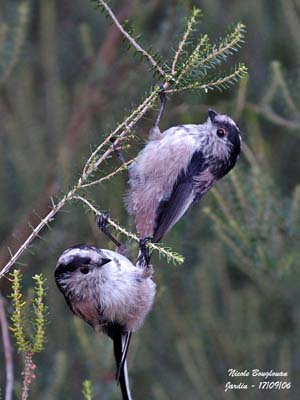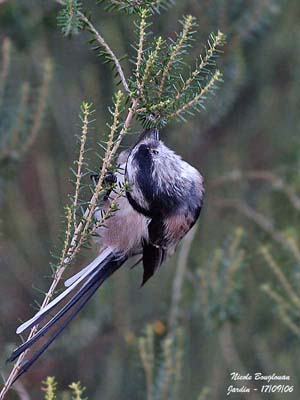
Long-tailed Tit
Aegithalos caudatus
Passeriform Order – Aegithalidae Family
BIOMETRICS:
Length: 13-16 cm
Wingspan: 6-10 cm
Weight: 6-10, 5 g
DESCRIPTION:
Long-tailed Tit is a small bird with rounded body, very short bill and long tail (about 7 to 9 cm). The plumage appears mainly black and white, with variable grey and pink washes.

On the upperparts, upper mantle is black whereas the lower part and the back are mixed black and pinkish-white or whitish. Scapulars and rump are pink with black and white mottling.
The uppertail coverts and the tail are black, with external white rectrices. Upperwing coverts and alula are black. The greater coverts are tipped and edged white. The flight feathers are dark brown to blackish, with broadly edged white tertial and secondary feathers.

The underparts are pink, slightly streaked with black, paler on belly. Undertail is black and white with graduated white external rectrices.

Head is black and pink. A wide central pink band extends from forehead to nape, whereas head-sides above the eyes are black. Chin, throat and cheeks are pink tinged black.
The short bill is blackish. Eyes are blackish with red eyelid, variable until yellow according to the mood. Legs and feet are blackish.
Both sexes are similar.
Juvenile is darker than adults, with dusky face and centre of crown, and whitish forehead. Tail is shorter and blackish-brown.
We can find numerous subspecies with marked variations in plumage pattern and colours.
VOICE: SOUNDS BY XENO-CANTO
Long-tailed Tit is a very vocal bird. The contact call is a high-pitched “see-see-see” given in flight when the flock moves rapidly, and uttered by isolated birds from the main flock.
We can hear a flatter “tup” mixed with thin “tseet” notes.
When the bird is threatened or excited, it utters short and explosive rattling trills falling towards the end “tsirrrup”.
During disputes between groups, we can hear louder and harder versions of the previous calls.
There is not territorial song, but the birds may occasionally utter soft twittering and trilling. These songs are given by both sexes during aggressive disputes, copulation, nest building and feeding of the young.

HABITAT:
Long-tailed Tit frequents hedges and bushes. It is found in woodlands, deciduous and mixed forests with shrub layer, and wooded suburban parks and gardens.
RANGE:
Long-tailed Tit is an European bird living from Western Europe to Central Japan.

BEHAVIOUR:
Long-tailed Tit feeds mainly on insects, foraging in lichen. It often hangs upside down by only one foot, and it holds large food items in the other for eating them. We can see it on trunk and branches, pecking invertebrates from twigs, leaves and buds.
It can hover and sometimes flycatches for reaching the food. It also may forage on the ground.
This species is very gregarious, living in flocks all year round. These groups include adults and young of the previous season, and also some adult-helpers involved in raising brood.
There are quite feeding periods alternated with noisy rapid movements, when the flock moves to other feeding area.

Long-tailed Tit flock defends its territory against other groups. These birds roost communally, huddling together for warmth in horizontal branches.
After the breeding season, the family group and the larger flocks move through woods and along hedges, often with other species.
Long-tailed Tit is resident in the temperate areas of the range, but the birds of the northern parts are partially migratory.
FLIGHT:
Long-tailed Tit performs weak and whirring flight with rapid wing beats.
In order to cross an open area, the birds gather together, calling loudly before to cross the area in single file and with an undulating flight.
REPRODUCTION:
Breeding season usually occurs from mid-March to June in Europe, but may vary according to the geographic range.
Pair forms in late winter or early spring when the flock breaks up. The male performs flight displays, a “butterfly-like” jerky flight, flying up to 5-6 metres above the ground, alternatively closing and fanning its tail before to dive down vertically. Often 3-4 birds display in rapid succession.
The nest is usually placed at about 3 metres above the ground, in a low thorny bush or in tree fork. The nest is built by both adults over about one month. It is an oval purse of moss, webs and lichen, domed and compact. Exterior is entirely covered with lichen which provides excellent camouflage. There is a lateral entrance hole. Interior is lined with small feathers in great numbers. The lining it maintained and feathers are regularly added during the laying period.

Female lays 6 to 15 white eggs spotted with red. Incubation by female lasts about 12 to 18 days. The male feeds her during this period.
Chicks are fed and cared by both adults assisted by helpers.
The young leave the nest at 14-18 days of age, but they depend on parents and helpers for food for two weeks more.
The family group remains together during the winter.

DIET:
Long-tailed Tit feeds mainly on invertebrates, but it also takes seeds, buds, olives and peanuts, often in autumn and winter. It also drinks sap.
PROTECTION / THREATS / STATUS:
Long-tailed Tits are common in most parts of the range, and more local to rare in some areas.
The deforestation and changes in the habitat, and the harsh winter weather caused declines in populations. Some predators such as crows, weasels and snakes also are other threat for this species.
Fr: Mésange à longue queue
All : Schwanzmeise
Esp: Mito Común
Ital: Codibugnolo
Nd: Staartmees
Russe: Длиннохвостая синица
Sd: Stjärtmes
Photographers:
John Anderson
John Anderson Photo Galleries
Nicole Bouglouan
PHOTOGRAPHIC RAMBLE
Text by Nicole Bouglouan
Sources :
HANDBOOK OF THE BIRDS OF THE WORLD Vol 13 by Josep del Hoyo-Andrew Elliot-Jordi Sargatal - Lynx Edicions – ISBN: 9788496553453
THE HANDBOOK OF BIRD IDENTIFICATION FOR EUROPE AND THE WESTERN PALEARCTIC by Mark Beaman, Steve Madge - C.Helm - ISBN: 0713639601
L’ENCYCLOPEDIE MONDIALE DES OISEAUX - Dr Christopher M. Perrins - BORDAS - ISBN: 2040185607
Wikipedia (Wikipedia, The Free Encyclopedia)
